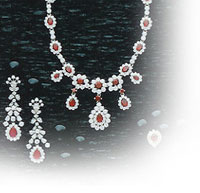Russians may spend over 2 billion dollars on jewelry as New Year gifts
Russians spend about two billion dollars on New Year jewelry presents. The news was revealed by the chairman of jewelry maker Choron Diamond, Rajesh Gandhi.

Jewelry sales bring about six billion dollars of annual profit in Russia. About 30 percent of the income is received during New Year holidays. Precious metals and precious stones jewelry makes about 50 percent of the entire sales volume atthis point.
The interest in high-quality and expensive jewelry has been rising in Russia during the recent several years. Over 20 percent of Russians plan to choose jewelry as their New Year presents.
As far as Muscovites are concerned, they are ready to spend up to 2,000 dollars on New Year presents, depending on income and likings. However, jewelry is not the most popular gift in Russia. Most often, Russians prefer to give perfumes and cosmetic products, toys, CDs, DVDs and cell phones. The list of most popular gifts ends with expensive gifts such as computers, trips to a foreign country and cars.
The modern jewelry movement began in the late 1940s at the end of World War II with a renewed interest in artistic and leisurely pursuits. The movement is most noted with works by Georg Jensen and other jewelry designers who advanced the concept of wearable art. The advent of new materials, such as plastics, Precious Metal Clay (PMC) and different coloring techniques, has led to increased variety in styles. Other advances, such as the development of improved pearl harvesting by people such as Kokichi Mikimoto and the development of improved quality artificial gemstones such as moissanite (a diamond simulant), has placed jewelry within the economic grasp of a much larger segment of the population. The "jewelry as art" movement, spearheaded by artisans such as Robert Lee Morris and continued by designers such as Anoush Waddington in the UK, has kept jewelry on the leading edge of artistic design. Influence from other cultural forms is also evident; one example of this is bling-bling style jewelry, popularized by hip-hop and rap artists in the early 21st century. With the world's designs more accessible to jewelers, designs have blended in aspects from many different cultures from many different periods in time.
The largest jewelry market is the United States with a market share of 30.8 percent, Japan, India and China and the Middle East each with 8 – 9 percent and finally Italy with 5 percent. They predict a dramatic change in relative market shares by 2015, where the market share of the United States will have dropped to around 25 percent, and China and India will increase theirs to over 13 percent. The Middle East will remain more or less constant at 9 percent, whereas Europe's and Japan's market share will be halved and become less than 4 percent for Japan, and less than 3 percent for the biggest individual European countries: Italy and the UK.
Prepared by Dmitry Sudakov
Pravda.ru
Subscribe to Pravda.Ru Telegram channel, Facebook, RSS!


